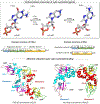Allostery, and how to define and measure signal transduction
- PMID: 35121384
- PMCID: PMC8898294
- DOI: 10.1016/j.bpc.2022.106766
Allostery, and how to define and measure signal transduction
Abstract
Here we ask: What is productive signaling? How to define it, how to measure it, and most of all, what are the parameters that determine it? Further, what determines the strength of signaling from an upstream to a downstream node in a specific cell? These questions have either not been considered or not entirely resolved. The requirements for the signal to propagate downstream to activate (repress) transcription have not been considered either. Yet, the questions are pivotal to clarify, especially in diseases such as cancer where determination of signal propagation can point to cell proliferation and to emerging drug resistance, and to neurodevelopmental disorders, such as RASopathy, autism, attention-deficit/hyperactivity disorder (ADHD), and cerebral palsy. Here we propose a framework for signal transduction from an upstream to a downstream node addressing these questions. Defining cellular processes, experimentally measuring them, and devising powerful computational AI-powered algorithms that exploit the measurements, are essential for quantitative science.
Keywords: Allosteric; Artificial intelligence; Cellular network; Deep learning; Neurodevelopmental disorders; Signaling.
Copyright © 2022. Published by Elsevier B.V.
Conflict of interest statement
Declaration of Competing Interest
The authors declare that they have no conflicts of interest with the content of this article.
Declaration of interests
The authors declare that they have no known competing financial interests or personal relationships that could have appeared to influence the work reported in this paper.
Figures


Similar articles
-
A systematic review of comorbidity between cerebral palsy, autism spectrum disorders and Attention Deficit Hyperactivity Disorder.Eur J Paediatr Neurol. 2019 Jan;23(1):31-42. doi: 10.1016/j.ejpn.2018.10.005. Epub 2018 Nov 2. Eur J Paediatr Neurol. 2019. PMID: 30446273
-
Inattention and hyperactivity/impulsivity among children with attention-deficit/hyperactivity-disorder, autism spectrum disorder, and intellectual disability.Res Dev Disabil. 2017 Nov;70:175-184. doi: 10.1016/j.ridd.2017.09.009. Epub 2017 Sep 26. Res Dev Disabil. 2017. PMID: 28957735
-
Language deficits in specific language impairment, attention deficit/hyperactivity disorder, and autism spectrum disorder: An analysis of polygenic risk.Autism Res. 2020 Mar;13(3):369-381. doi: 10.1002/aur.2211. Epub 2019 Oct 2. Autism Res. 2020. PMID: 31577390 Free PMC article.
-
[Intellectual developmental disability overlapping with autism spectrum disorder and attention deficit-hyperactivity disorder].Medicina (B Aires). 2018;78 Suppl 2:63-68. Medicina (B Aires). 2018. PMID: 30199368 Review. Spanish.
-
[Autism spectrum disorder and attention-deficit/hyperactivity disorder: challenge in diagnosis and treatment].Medicina (B Aires). 2022 Aug 30;82 Suppl 3:67-70. Medicina (B Aires). 2022. PMID: 36054861 Review. Spanish.
Cited by
-
AlphaFold, Artificial Intelligence (AI), and Allostery.J Phys Chem B. 2022 Sep 1;126(34):6372-6383. doi: 10.1021/acs.jpcb.2c04346. Epub 2022 Aug 17. J Phys Chem B. 2022. PMID: 35976160 Free PMC article. Review.
-
A New View of Activating Mutations in Cancer.Cancer Res. 2022 Nov 15;82(22):4114-4123. doi: 10.1158/0008-5472.CAN-22-2125. Cancer Res. 2022. PMID: 36069825 Free PMC article.
-
Cancer and Autism: How PTEN Mutations Degrade Function at the Membrane and Isoform Expression in the Human Brain.J Mol Biol. 2023 Dec 15;435(24):168354. doi: 10.1016/j.jmb.2023.168354. Epub 2023 Nov 5. J Mol Biol. 2023. PMID: 37935253 Free PMC article.
-
CDK2 and CDK4: Cell Cycle Functions Evolve Distinct, Catalysis-Competent Conformations, Offering Drug Targets.JACS Au. 2024 May 14;4(5):1911-1927. doi: 10.1021/jacsau.4c00138. eCollection 2024 May 27. JACS Au. 2024. PMID: 38818077 Free PMC article.
-
Single cell spatial biology over developmental time can decipher pediatric brain pathologies.Neurobiol Dis. 2024 Sep;199:106597. doi: 10.1016/j.nbd.2024.106597. Epub 2024 Jul 9. Neurobiol Dis. 2024. PMID: 38992777 Review.
References
-
- Hannezo E, Heisenberg CP, Mechanochemical Feedback Loops in Development and Disease, Cell, 178 (2019) 12–25. - PubMed
Publication types
MeSH terms
Grants and funding
LinkOut - more resources
Full Text Sources
Medical

